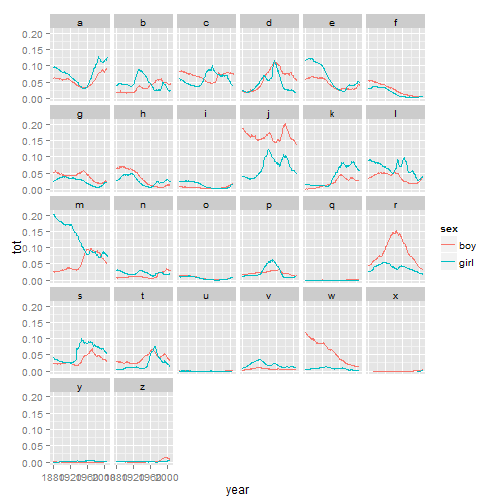library(plyr)
library(ggplot2)
Example data
library(RCurl)
myCsv <- getURL("https://dl.dropboxusercontent.com/u/8272421/bnames.csv", ssl.verifypeer = FALSE)
myData <- read.csv(textConnection(myCsv))
myData$name = as.character(myData$name)
myData$sex = as.character(myData$sex)
head(myData)
year name percent sex
1 1880 John 0.08154 boy
2 1880 William 0.08051 boy
3 1880 James 0.05006 boy
4 1880 Charles 0.04517 boy
5 1880 George 0.04329 boy
6 1880 Frank 0.02738 boy
transform() modifies an existing data frame.
Define functions
# get the nth character
letter <- function(x, n = 1) {
if (n < 0) {
nc <- nchar(x)
n <- nc + n + 1
}
tolower(substr(x, n, n))
}
# get the number of vowels
vowels <- function(x) {
nchar(gsub("[^aeiou]", "", x))
}
Simple transformation
bnames = myData
bnames0 <- transform(bnames, first = letter(name, 1), last = letter(name, -1),
length = nchar(name), vowels = vowels(name))
head(bnames0)
year name percent sex first last length vowels
1 1880 John 0.08154 boy j n 4 1
2 1880 William 0.08051 boy w m 7 3
3 1880 James 0.05006 boy j s 5 2
4 1880 Charles 0.04517 boy c s 7 2
5 1880 George 0.04329 boy g e 6 3
6 1880 Frank 0.02738 boy f k 5 1
Group-wise transformation
compute the rank of a name within a sex and year (e.g. boy & 2008)?
one <- subset(myData, sex == "boy" & year == 2008)
# ties.method = 'first' -- first occurrence wins
one <- transform(one, rank = rank(-percent, ties.method = "first"))
head(one)
year name percent sex rank
128001 2008 Jacob 0.010355 boy 1
128002 2008 Michael 0.009437 boy 2
128003 2008 Ethan 0.009301 boy 3
128004 2008 Joshua 0.008799 boy 4
128005 2008 Daniel 0.008702 boy 5
128006 2008 Alexander 0.008566 boy 6
Transform every sex and year
# short the data to easily see the results
bnames = myData[c(1:2, 9999:10000, 129001:129002, 257998:258000), ]
bnames
year name percent sex
1 1880 John 0.081541 boy
2 1880 William 0.080511 boy
9999 1889 Collie 0.000042 boy
10000 1889 Cooper 0.000042 boy
129001 1880 Mary 0.072381 girl
129002 1880 Anna 0.026678 girl
257998 2008 Kenley 0.000127 girl
257999 2008 Sloane 0.000127 girl
258000 2008 Elianna 0.000127 girl
# rank by sex and then by year
bnames1 <- ddply(bnames, c("sex", "year"), transform, rank = rank(-percent,
ties.method = "first"))
bnames1
year name percent sex rank
1 1880 John 0.081541 boy 1
2 1880 William 0.080511 boy 2
3 1889 Collie 0.000042 boy 1
4 1889 Cooper 0.000042 boy 2
5 1880 Mary 0.072381 girl 1
6 1880 Anna 0.026678 girl 2
7 2008 Kenley 0.000127 girl 1
8 2008 Sloane 0.000127 girl 2
9 2008 Elianna 0.000127 girl 3
# rank by yaer and then by sex
bnames2 <- ddply(bnames, c("year", "sex"), transform, rank = rank(-percent,
ties.method = "first"))
bnames2
year name percent sex rank
1 1880 John 0.081541 boy 1
2 1880 William 0.080511 boy 2
3 1880 Mary 0.072381 girl 1
4 1880 Anna 0.026678 girl 2
5 1889 Collie 0.000042 boy 1
6 1889 Cooper 0.000042 boy 2
7 2008 Kenley 0.000127 girl 1
8 2008 Sloane 0.000127 girl 2
9 2008 Elianna 0.000127 girl 3
summarise() creates a new data frame.
Simple summaries
Whole dataset summaries
summarise(bnames, max_perc = max(percent), min_perc = min(percent))
max_perc min_perc
1 0.08154 4.2e-05
Group-wise summaries
bnames = bnames0
sum.name = ddply(bnames, c("name"), summarise, tot = sum(percent))
head(sum.name)
name tot
1 Aaden 0.000442
2 Aaliyah 0.019748
3 Aarav 0.000101
4 Aaron 0.293097
5 Ab 0.000218
6 Abagail 0.001326
sum.length = ddply(bnames, c("length"), summarise, tot = sum(percent))
head(sum.length)
length tot
1 2 0.2315
2 3 7.2744
3 4 36.8475
4 5 57.7588
5 6 60.3609
6 7 44.3370
sum.year.sex = ddply(bnames, c("year", "sex"), summarise, tot = sum(percent))
head(sum.year.sex)
year sex tot
1 1880 boy 0.9307
2 1880 girl 0.9345
3 1881 boy 0.9304
4 1881 girl 0.9327
5 1882 boy 0.9275
6 1882 girl 0.9310
sum.sex.year = ddply(bnames, c("sex", "year"), summarise, tot = sum(percent))
head(sum.sex.year)
sex year tot
1 boy 1880 0.9307
2 boy 1881 0.9304
3 boy 1882 0.9275
4 boy 1883 0.9288
5 boy 1884 0.9273
6 boy 1885 0.9255
The proportion of the first letter (by year)
sum.year.sex.first <- ddply(bnames, c("year", "sex", "first"), summarise, tot = sum(percent))
qplot(year, tot, data = sum.year.sex.first, geom = "line", colour = sex, facets = ~first)

The proportion of US children who have a name in the top 100 (by year)
# rank by sex and then by year
bnames = myData
bnames = ddply(bnames, c("sex", "year"), transform, rank = rank(-percent, ties.method = "first"))
# top 100
top100 <- subset(bnames, rank <= 100)
top100s <- ddply(top100, c("sex", "year"), summarise, tot = sum(percent))
qplot(year, tot, data = top100s, colour = sex, geom = "line", ylim = c(0, 1))

ddply
Simple example
top100 <- subset(bnames, rank <= 100)
top100s <- ddply(top100, c("sex", "year"), summarise, tot = sum(percent))
head(top100s)
sex year tot
1 boy 1880 0.7478
2 boy 1881 0.7466
3 boy 1882 0.7416
4 boy 1883 0.7438
5 boy 1884 0.7387
6 boy 1885 0.7342
ddply with your own defined function
One simple function
top100m <- ddply(top100, c("sex", "year"), function(df) mean(df$percent))
head(top100m)
sex year V1
1 boy 1880 0.007478
2 boy 1881 0.007466
3 boy 1882 0.007416
4 boy 1883 0.007438
5 boy 1884 0.007387
6 boy 1885 0.007342
More than one function
top100ms <- ddply(top100, c("sex", "year"), function(df) c(mean(df$percent),
sd(df$percent)))
head(top100ms)
sex year V1 V2
1 boy 1880 0.007478 0.01381
2 boy 1881 0.007466 0.01361
3 boy 1882 0.007416 0.01320
4 boy 1883 0.007438 0.01313
5 boy 1884 0.007387 0.01268
6 boy 1885 0.007342 0.01241
Set the column names
top100ms2 <- ddply(top100, c("sex", "year"), function(df) data.frame(mean = mean(df$percent),
se = sd(df$percent)/sqrt(length(df$percent))))
head(top100ms2)
sex year mean se
1 boy 1880 0.007478 0.001381
2 boy 1881 0.007466 0.001361
3 boy 1882 0.007416 0.001320
4 boy 1883 0.007438 0.001313
5 boy 1884 0.007387 0.001268
6 boy 1885 0.007342 0.001241
xxply
array dataFrame list
array aaply adply alply
dataFrame daply ddply dlply
list laply ldply llply